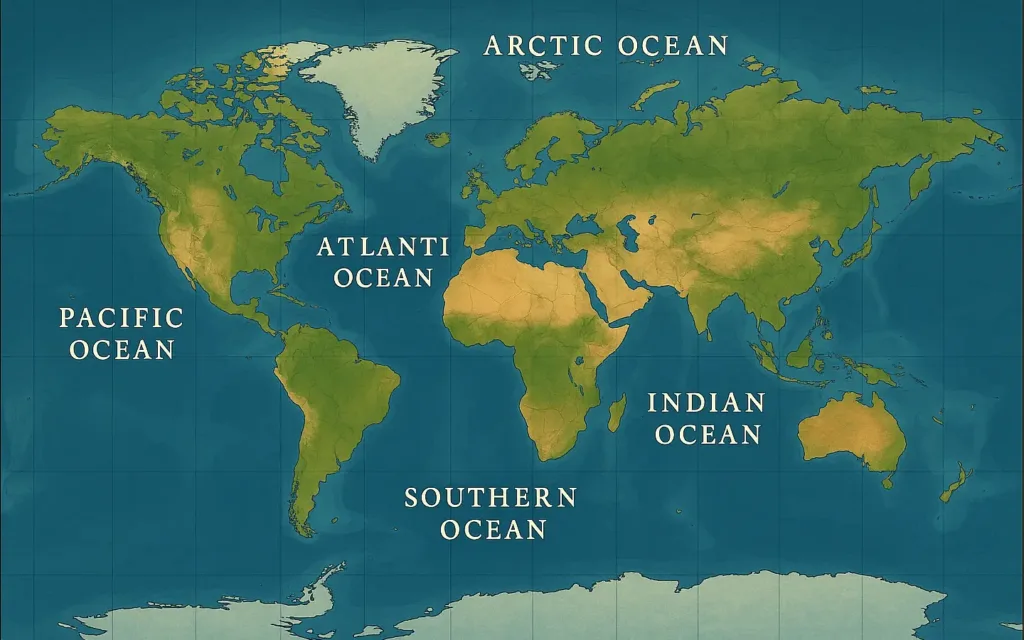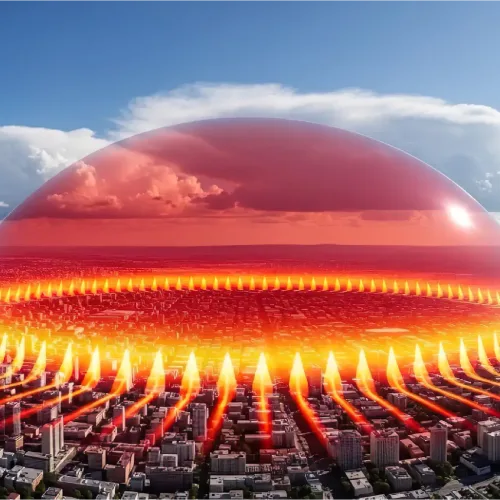Oceans cover over 70% of the Earth. It is remarkable to think about how unbelievable it is. These vast, interconnected bodies of water shape everything from our climate to ecosystems and even human civilization itself. But here’s a question that comes up all the time: how many oceans are there really in the world? You might think the answer is simple, but the way we classify oceans has changed quite a bit over the years, leading to some lively debates among geographers and marine scientists.
Formerly, we have heard about four major oceans: the Pacific, Atlantic, Indian, and Arctic. But then in 2000, things changed when the International Hydrographic Organization recognized a fifth ocean, the Southern Ocean, which hugs Antarctica. This was a big deal and really shook up the world of oceanography, giving us a new way to think about how we categorize the waters on our earth.
Now, understanding oceans isn’t just about where they are on a map. It’s also about recognizing how crucial they are for everything, like weather patterns, biodiversity, and global trade. So, in this article, we’re going to dive into the five recognized oceans, exploring their names, geography, and why they’re significant. Moreover, we’ll clear up some history behind how we classify these oceans and tackle some burning questions about what makes each one unique. Let’s get started!
How Many Oceans in the World?
For centuries, scientists and explorers have been figuring out the oceans based on things like geography, trade routes, and where the continents are. Back in the day, they typically talked about just four main oceans. But these days? It’s all about recognizing five. So, what’s behind this change? Let’s dig into that and see why the Southern Ocean is now getting its due recognition.
| Aspect | 4-Ocean Model | 5-Ocean Model |
|---|---|---|
| Recognized Oceans | Pacific, Atlantic, Indian, Arctic | Pacific, Atlantic, Indian, Arctic, Southern |
| Historical Usage | Traditional view used before the 21st century | Adopted officially in 2000 by the International Hydrographic Organization (IHO) |
| Southern Ocean | Considered part of the Pacific, Atlantic, and Indian Oceans | Recognized as a distinct ocean surrounding Antarctica |
| Geographical Basis | Continental separations | Unique current system (Antarctic Circumpolar Current) |
| Scientific Consensus | Still used in some regions | Widely accepted by NOAA, IHO, and oceanographers |
| Educational Usage | Found in older textbooks and regional curricula | Found in modern geography and environmental sciences |
The five-ocean model really does make more sense with how we understand oceanography today. Still, it’s interesting that there are some differences depending on where you are. For example, some countries’ curricula exclude the Southern Ocean, viewing it as part of the Pacific, Atlantic, and Indian Oceans.
Historical Perspective

Back in ancient times, people saw all the waters of the world as one huge, endless ocean. Early Greek geographers, like Ptolemy, thought there was just one big ocean, using different names for various regions mainly to help with navigation. As explorers set sail and ventured further, they began to recognize the distinct bodies of water we know today.
Then, during the Age of Exploration, which stretched from the 15th to the 18th centuries, European mapmakers really got into the nitty-gritty of mapping. They started drawing clear boundaries for the oceans, basing them on where the continents separated. It set the stage for what we now think of as the four-ocean model, which stuck around until not too long ago—you know, just into the late 20th century. For more inspiration, you can look at the book National Geographic Atlas of the Ocean: The Deep Frontier. It has a lot of beautiful maps and pictures.
Modern Classification
Nowadays, most folks, including big organizations like the National Oceanic and Atmospheric Administration, are on board with the five-ocean model. The recognition of the Southern Ocean, got its official recognition back in 2000 was a big deal because it highlighted the ocean’s unique currents and its important role in the ecosystem. There are still some countries out there that stick to the older four-ocean model in their schools. It just shows you how complicated classifying our oceans can be!
Names and Geography of the Five Oceans
Earth’s oceans play a crucial role in shaping global climate, trade, and ecosystems. While they are all connected, each of the five oceans has specific characteristics. Let’s explore their geography, sizes, and unique features.

1. Pacific Ocean
Pacific Ocean is the largest and deepest ocean globally. It covers about 63 million square miles! It lies between Asia, Australia, and the Americas, and get this—it holds the Mariana Trench, which is the deepest part of all the oceans we know.
But it’s not just about its size. The Pacific Ocean plays a big role in shaping our global climate. Have you ever heard of El Niño or La Niña? Those phenomena are pretty much influenced by this massive body of water. Furthermore, it’s like a treasure chest of marine life, boasting some of the most diverse ecosystems, including the famous Great Barrier Reef.
2. Atlantic Ocean
The Atlantic Ocean, which lies between the Americas, Europe, and Africa, is actually the second-largest ocean out there. It’s fascinating when you think about its history. This ocean has been crucial for exploration, trade, and migration over the centuries. It’s like a bridge connecting different continents through those major sea routes.
One of its standout features is the Mid-Atlantic Ridge. Imagine this huge underwater mountain range that stretches right down the center of the ocean! Also, let’s not forget how the Atlantic plays a significant role in hurricane formation, especially affecting places like the Gulf of Mexico. It’s interesting to see how this vast body of water impacts weather patterns too.
3. Indian Ocean
The Indian Ocean is the third-largest ocean in the world. It’s famous for its warm waters and powerful monsoon systems that can really shake things up. Moreover, it’s very important for global trade, too. You’ve got major shipping routes linking the Middle East, India, and Africa, which is extremely crucial for commerce.
And let’s talk about its ecology for a moment. This ocean is bursting with life, especially when you look at the stunning coral reefs and diverse marine species, like those found in the Maldives and Seychelles. Don’t forget the Mozambique Channel and the Bay of Bengal—those areas are particularly significant within the Indian Ocean. It’s a fascinating part of the world, for sure!
4. Arctic Ocean
The Arctic Ocean is the smallest and coldest of all the oceans, stretching over roughly 5.4 million square miles. It’s up there at the very top of the world, mostly covered in ice. But here’s the thing—climate change is really taking a toll on those ice levels, and it’s pretty alarming.
This ocean does a lot more than just sit there; it’s quite important for regulating the climate and has a big impact on how oceanic currents move around the globe. And even though it’s got some harsh conditions, it’s still home to some fascinating arctic wildlife, such as polar bears, narwhals, and other unique creatures that have adapted to this icy environment.
5. Southern Ocean
So, the Southern Ocean—it’s fascinating. Officially recognized back in 2000, it wraps around Antarctica and connects three major oceans: the Pacific, Atlantic, and Indian.
Now, what’s really fascinating is the Antarctic Circumpolar Current. This current is a powerhouse, driving global ocean circulation. It does a lot more than just flow around, though. The Southern Ocean is crucial for our climate. It absorbs carbon dioxide and has a big say in how ocean currents behave worldwide. This ocean is teeming with life, such as penguins, seals, and krill. Seriously, it’s a bustling hub of marine biodiversity. So, next time you think about oceans, remember that the Southern Ocean is doing some heavy lifting for our planet! Continents & Oceans (Discover & Learn) is also afun for young explorers. This colorful guide is perfect for mini geographers.
The Role of Oceans in Our Planet
Oceans, they’re not just huge and stunning. They actually do a lot more for our world. They help keep our climate in check, give a home for countless marine life forms, and even influence major weather patterns. It’s pretty amazing how much they contribute to life as we know it!
How Oceans Influence Weather Patterns
Oceans do a lot more than just look pretty. They act like natural climate regulators, soaking up solar heat and spreading it around the world. It’s stunning how the movement of ocean currents can affect weather patterns and even the seasons.
Take El Niño and La Niña, for instance. These are very crucial phenomena caused by changes in temperature in the Pacific Ocean. When that happens, it sends ripples through global weather patterns. We’re talking about droughts, hurricanes, and those unusual temperature swings that can leave everyone scratching their heads.

Cultural and Economic Roles
If we look back through history, one thing is clear: oceans have played a huge role in exploration, trade, and navigation. For example, ancient Polynesians were incredible navigators, relying solely on the stars, the winds, and the waves to find their way across the vast seas.
Fast-skip to today, and the oceans are still incredibly important. I mean, think about all the industries that rely on them, like fishing, tourism, international shipping, and you name it. Major trade routes crisscross the oceans, linking economies from all over the world. And coastal communities really depend on marine resources to make a living. It’s fascinating how these bodies of water continue to shape our lives.
Conclusion: A Planet United by Water
Oceans are more than just huge stretches of water. They’re like the heartbeat of our planet, shaping climate, supporting biodiversity, and playing a major role in human life. Each ocean has its own unique vibe, but they’re all linked together, creating one big, interconnected system.
As we dive deeper into exploring and studying these incredible oceans, we are constantly discovering new mysteries and stumbling upon environmental challenges. There’s a lot to consider, and we also find ways to protect these precious waters. Just understanding their geography is only the start; the real challenge is how we can protect them for future generations. It’s a big responsibility, but one that’s absolutely worth it!
Recommended Read for Curious Minds
Want to explore more? Here are some great books to inspire you. Add them to your reading list!
- National Geographic Ocean: A Global Odyssey by Syliva A. Earle
- The Sea Around Us by Rachel Carson
- The Wave: In Pursuit of the Rogues, Freaks, and Giants of the Ocean by Susan Casey
Frequently Asked Questions
There are five oceans: the Pacific, Atlantic, Indian, Southern, and Arctic Ocean.
The Pacific Ocean is the largest, covering more area than all the land on Earth combined.
The Arctic Ocean is the smallest and shallowest ocean on Earth.
Oceans are large bodies of saltwater that cover huge areas, while seas are smaller, partly enclosed by land, and usually connected to an ocean.
Oceans regulate climate, produce oxygen, support marine life, and provide food, transport, and resources for humans.





2 Comments
If some one wants to be updated with newest technologies afterward he must
be go to see this website and be up to date daily.
Thanks a lot! That’s exactly what I aim for, keeping everyone updated with the latest tech in simple words.